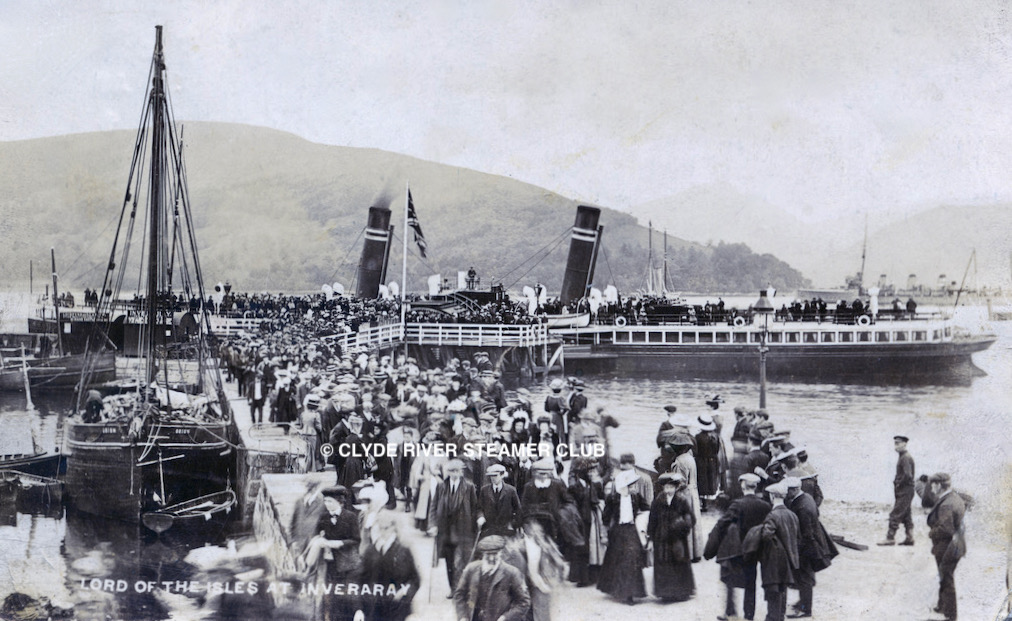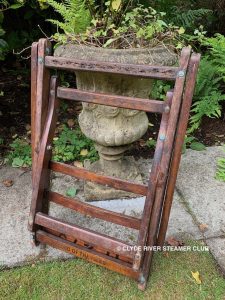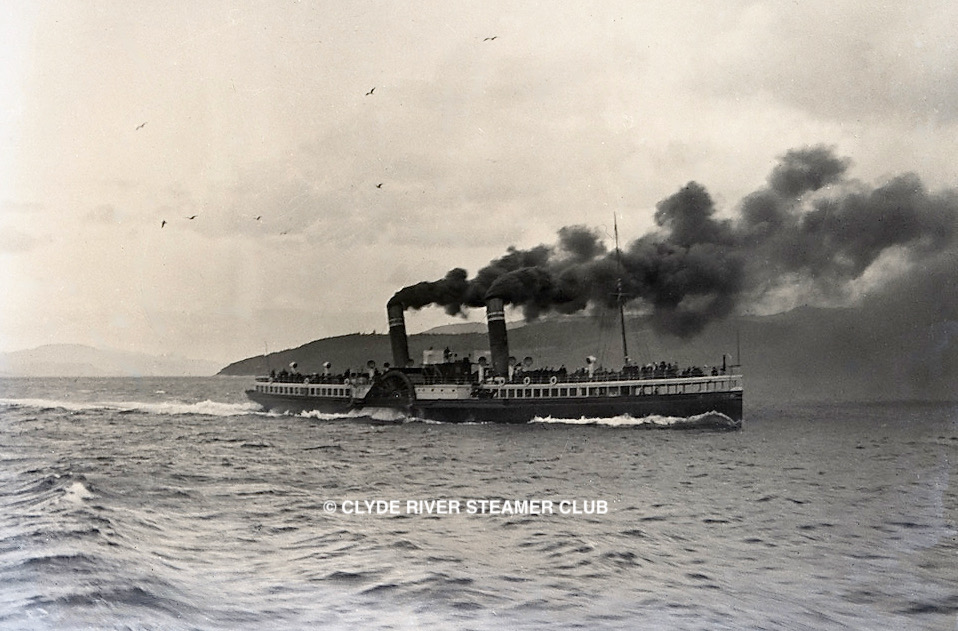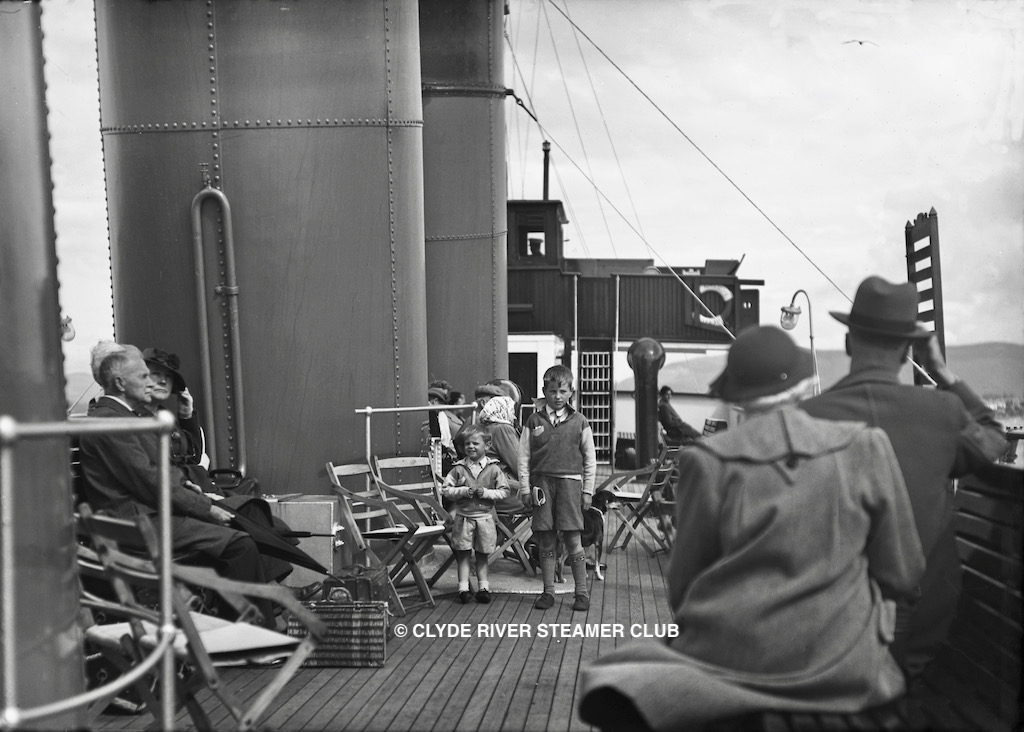
Lord of the Isles shortly after her arrival at Inveraray c1900: somewhere in this crowd may be a passenger who used a deck chair marked M275. More than a century later, that chair is now in CRSC’s care
CRSC has been gifted a deck chair from the 1891 Lord of the Isles. It may well be the last of its kind. Andrew Clark reports.
More than a century ago, the varnished wooden legs of this curious seat rested on the decks of a famous 1891 paddle steamer, plying between Glasgow and Inveraray throughout the summer.

The folded deck chair without canvas seat: you can see how constant re-stapling has damaged the wood on the top bar where the canvas seat needs to be firmly attached. The bottom bar bears the ship’s name. Click on the image to enlarge
Over the years its simple, sturdy structure gave countless tourists and trippers a resting place on the open deck, where they could sit quietly in the sun and enjoy the passing scenery.
This rare relic of the past has been donated to CRSC by Iain MacArthur, who found it languishing in distressed condition, with no canvas seating, in an out-of-use locker when he was Assistant Purser of Duchess of Montrose in 1958.
The chair was recently treated to minor repairs, and is now stored in the CRSC Archive. At a suitable point in the future, it may be exhibited at a Club meeting in Glasgow.
We know it belonged to the second ‘Lord’ because her name is clearly branded on it: this is no fake.
A wooden deck chair was once a desirable accessory for a day’s excursion on the Clyde, to be hired for a small fee and stationed somewhere near the funnels or on the after deck. At the end of the cruise you left it for the deck boy to clear away and store in the locker.
When steamers went for winter layup, it was common practice for their deck chairs to be offloaded at Greenock for stowage and repair ashore. If a ship went to the breakers, her chairs would be distributed the following spring among her fleet mates.
So it was with Lord of the Isles after her final season in 1928. Her chairs were distributed among the ‘doon the watter’ fleet of her last owners, the Williamson-Buchanan/Turbine Steamers Ltd combine.
When the combine was dissolved in 1936, its ‘doon the watter’ fleet was taken over by the LMS — whose Clyde fleet included Duchess of Montrose, one of the crack steamers of her day. Through sheer luck (and Iain MacArthur’s timely act of rescue), this particular deck chair has lasted ‘through the ages’.
Seen outside its original shipboard environment, especially in ‘stowage’ position, the deck chair is an unremarkable concoction of wooden spars and old screws.
Its value today lies in the branding of the ship’s name, face down (i.e. out of sight when in use) on the lowest spar, revealing the chair’s unmistakable provenance.
As excursion steamers disappeared one by one from the Clyde scene in the 1960s and 1970s, so did the deck chairs — thousands of them, each with a canvas seat stapled into the wood and a code printed on the back, giving a clue to its origin.
Where did they all go? Recycling was virtually unknown 50 years ago. If they weren’t used as firewood, they almost certainly went to the dump or the incinerator.
But a lucky remnant of the second ‘Lord’ (or perhaps even her 1877 predecessor?) has survived — a reminder of the palmy days when you could sail in style from the centre of Glasgow to Inveraray and back in a day.
If you have a similar deck chair (or other steamer relic) and know something of its provenance, please write to info@crsc.org.uk

Lord of the Isles at speed: she was built in 1891 to compete with MacBrayne’s Columba for the prestigious Glasgow-Loch Fyne trade

Deck chairs, strewn around the deck as here on Saint Columba, were a familiar sight in the good old days

The official brochure for Lord of the Isles’ summer season was similar in style to that published by David MacBrayne Ltd for Columba. By 1905 Malcolm Turner Clark was manager and controlling shareholder of the two Glasgow-based companies dedicated to serving Inveraray, Lochgoilhead and Arrochar, but competition from Turbine Steamers Ltd led in 1912 to their liquidation and the takeover of Lord of the Isles, which thereafter undertook Round Bute excursions. Brochure cover reproduced courtesy of Alastair Chisholm

The 1891 ‘Lord’ was a bigger, more modern version of her 1877 namesake. In Clyde River and Other Steamers, Graham Langmuir described her as ‘always a popular, well known boat’, and her races with Columba in the upper Firth and East Kyle were legendary. Her last season was 1928, when she was chartered to David MacBrayne Ltd for the Glasgow-Lochgoilhead service
All images on the CRSC website are protected by copyright law. Do not reproduce them on Facebook, Pinterest or any other public platform.
Read more steamer stories on the CRSC website by clicking on News & Reports.
Published on 27 January 2021















